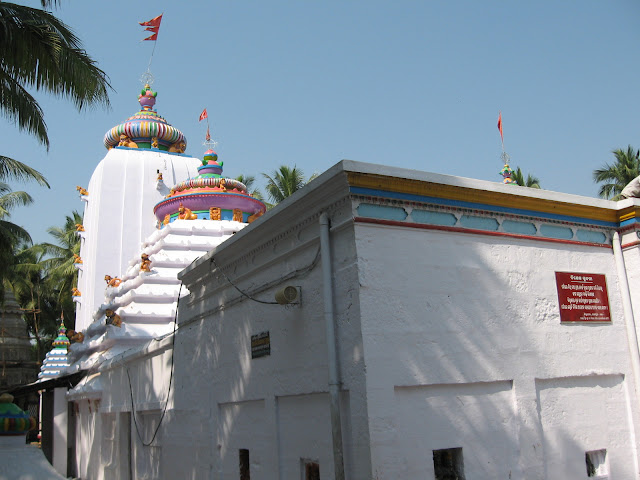 |
| The Goddess in Biraja Kshetra has only two hands and the prototype of this image is found nowhere else in the country |
Located in Jajpur town, the present 70-ft-high temple housing the two-armed Goddess was built in 13th century while the idol dates back to the pre-Gupta or Gupta period. In fact, historian Sunil Patnaik says the idol might date back to 2nd century AD. The Goddess in Biraja Kshetra has two hands, in one hand she pierces the chest of Mahishasura with a spear and in other, she pulls tail of the demon.
The Mahishasura is depicted as a buffalo and the presiding deity's right foot presses the head of the animal. She wears a crown that has the symbolism of Lord Ganesha, a Shiva Linga and a crescent moon and a Shivalinga. The prototype of this image is found nowhere else in the country.
Apparently, the perimeter of the Biraja Kshetra is triangular in form and the extreme points of the triangle in western, south-eastern and north-eastern directions are guarded by Shiva Lingams, who are regarded as guardian deities of the Kshetra. Goddess Biraja is seated in the circumcenter of the triangular region. According to the temple management, the temple was renovated by Pratap Rudra Dev of Suryavanshi Gajapati dynasty.
While the temple complex has many other temples of Lord Shiva, Hanuman, Goddess Bagalamukhi and Markandeswar, the added attraction is a holy pond 'Brahmakunda', which lies to the northwest and close to the Biraja temple. The pond is so named as it is believed that Lord Brahma had conducted a yagna here.
Maheswar Panigrahy, Sub-Collector of Jajpur and also the Chairman of Biraja Temple Managing Committee, says the temple sees a footfall of at least 1000 devotees everyday. On occasions like Durga Puja and Savitri, the footfall rises to 35,000 daily. One of the most interesting aspects of Devi worship at Biraja Kshetra is Rath Yatra of Goddess Biraja, which is held during Dussehra. Her chariot, Shimhadhwaja, carries the deity in a ceremonial procession around the temple compound once a day for nine days. There is a greater inflow of devotees to the temple from Southern Indian States like Andhra Pradesh, Karnataka and Tamil Nadu besides, the neighbouring West Bengal.
Panigrahy further says the State Government is now considering to develop a religious circuit comprising the Biraja temple, Baldevjew temple in Kendrapara, Sarala temple in Jagatsinghpur and Akhandalmani temple in Bhadrak. In fact, the Tourism Secretary LN Gupta had recently urged the Union Tourism Secretary Vinod Zutshi to consider inclusion of Biraja temple-Sarala-Akhandalamani-Baladevjew-Lalitgiri- Ratnagiri-Udayagiri under 'Swadesh Darshan' scheme of the Ministry.
Travellers Info
The temple is located at a distance of 125 km from Bhubaneswar and can be approached by road and rail. It has all amenities for tourists and for accommodation, the Odisha Tourism Development Corporation (OTDC) has a Panthasala. Besides, there are the PWD Bunglow and Circuit House in Jajpur town. Best time to visit is between October and January.


No comments:
Post a Comment
Thank You for Reading.